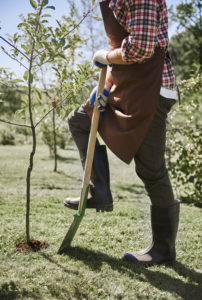Written by Jasper Boekelman and published on https://www.natorp.com/
Ideally, growing trees should be fertilized throughout the year but a bit differently as trees age. A tree needs larger amounts of nitrogen (N) based fertilizer during the growing season. Nitrogen-based solutions should be applied during the early spring and summer months.
Planting trees can give most patches of the earth some color and character. Although trees generally do not require a ton of maintenance aside from regular watering and intermittent pruning, they do benefit from the occasional application of fertilizer.
How to Feed Your Tree

WHEN SHOULD YOU FEED YOUR TREE?
Spring and mid to late fall are excellent times for feeding. If you’d like to do it yourself, here are the ways we recommend:
- FEEDING NEWLY PLANTED TREES
For new trees, use a root stimulant such as Bonide’s Plant Starter or Espoma’s Bio-tone. Both are light and easy feed for new trees and help promote early strong root development. Plant Starter is mixed with water and poured at the base of the tree. Bio-tone is added to the soil when backfilling around the tree.
- PLANTED 1-2 YEARS
For trees planted 1-2 years, we recommend using a water-soluble fertilizer such as Bonide’s Plant Starter or Miracle-Gro, pouring the mixture around the base of the tree. The Ross Root Feeder is another option for water-soluble fertilizing. It’s a unique tool (attaches to your garden hose) that injects the water-soluble fertilizer right into the soil, as well as helping in light soil aeration. Also, this can be used as a watering tool without adding the fertilizer!
- PLANTED 3 OR MORE YEARS
Fertilizing your lawn regularly with a lawn food helps to feed your existing trees.
Ross Root Feeders are an easy way to feed larger trees injecting a water-soluble fertilizer into the soil/root zone, as well as watering the tree and lightly aerating the soil. This is the same process professionals use to feed established and mature trees. Again, this tool is also an excellent way to water trees during periods of drought!
THE IMPORTANCE OF VERTICAL MULCHING
Vertical mulching is an excellent way to not only core aerate the soil around trees, but it can also be used to feed. Vertical mulching is the process of drilling a series of 2-inch diameter holes approximately 8 to 12 inches into the ground. These holes are drilled about 18-24 inches apart in a circular pattern, starting 6 feet or so away from the tree’s trunk, working your way out (circular pattern) to several feet past the drip line of the tree. The holes can be left open or backfilled with coarse products like sand, pea gravel, turface, or compost, followed by a good watering. This process opens up the soil around the tree for better airflow, better water absorption into the soil/root zone, and creating better areas for the roots to grow.
Vertical mulching can be used as a means of fertilizing the tree by adding a granular fertilizer to the backfill used to fill the open cores drilled around the tree. This also is an opportunity to apply soil amendments such as soil sulfur and Ironite for chlorotic trees. This is an excellent way to feed and helps improve the flow of air and water into the soil. It is time and labor-intensive, and maybe one to consider having a professional do for you!
CALCULATING THE AMOUNT OF FERTILIZER TO APPLY WITH VERTICAL MULCHING:
If using Espoma’s Tree-tone, Plant-tone, or Milorganite, read the label for amounts needed. Then, distribute the amount evenly into all the cored holes.
If using a fertilizer such as 10-10-10, look for a tree feeding rate on the bag. If nothing is available, then calculate using 1 pound per inch diameter, for tree trunks 1-6 inches in diameter. For those tree trunks 6 inches diameter or larger, use 3 pounds per inch diameter. Once finished, be sure to water with good soil soaking.
Original post here https://ift.tt/2SK4S1q.
from AAA Tree Lopping Ipswich https://ift.tt/3fWfVfV
via IFTTT
No comments:
Post a Comment